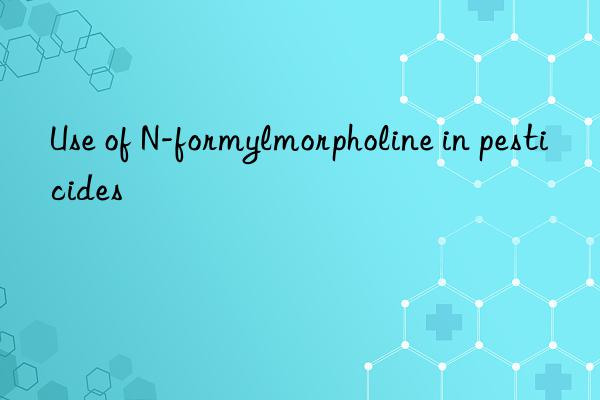
N-formylmorpholine (NFM), as an organic compound, has found its unique application in the field of agricultural chemistry value, especially in the formulation and functional enhancement of pesticides. The versatility of NFM makes it an indispensable ingredient in pesticide formulations. Below we will explore the specific applications of N-formylmorpholine in pesticides and the scientific principles behind it.
1. As a solvent and synergist in pesticide formulations
N-Formylmorpholine is widely used as a solvent in pesticide formulations due to its excellent solubility properties. It can dissolve a variety of pesticide active ingredients, including those that are difficult to dissolve in water or other conventional solvents, thereby improving pesticide formulation efficiency and product quality. In addition, NFM, as a synergist, can enhance the biological activity of pesticides and improve their adhesion and penetration ability on the surface of target crops, thereby improving the efficiency of pesticide use and control effects.
2. Improve the stability of pesticides
NFM helps improve the stability of pesticides, especially under complex environmental conditions. It can protect the active ingredients of pesticides from the effects of light, heat, oxidation and other factors, extend the shelf life of pesticides, and ensure activity during storage and transportation. This improved stability is critical to the pesticide industry as it is directly related to the reliability and cost-effectiveness of pesticides in practical applications.
3. As an intermediate for synthetic pesticides
In the process of pesticide synthesis, N-formylmorpholine can serve as a key chemical intermediate and participate in the construction of specific structural units of pesticide molecules. Through the participation of NFM, chemists can design and synthesize a series of new pesticide compounds with different biological activities. These compounds may have higher selectivity, lower ecological risks, and longer duration of action, thereby providing safer and more effective pest management solutions for agricultural production.
4. Promote bioavailability of pesticides
The addition of NFM can significantly improve the adhesion and permeability of pesticides on plant leaves, which means that more active ingredients can be absorbed by crops and reach target pests and diseases. This characteristic is extremely important for improving the bioavailability of pesticides, because only when a sufficient amount of pesticides reaches the pests and diseases can it effectively exert its control effect, while also reducing environmental pollution and resource waste caused by excessive spraying.
5. Used for pesticide residue detection
In the field of pesticide residue analysis, N-formylmorpholine is sometimes used as a solvent or derivatization reagent during sample processing. With the assistance of NFM, pesticide residues can be more efficiently extracted and purified from complex matrices, thereby achieving accurate determination of pesticide residues in food and the environment, ensuring food safety and ecological environment monitoring.
6. As a component of biopesticides
In recent years, biopesticides have received increasing attention due to their lower environmental impact and eco-friendliness. NFM is used as a carrier or auxiliary for active ingredients in some biopesticide formulas to help deliver biologically active substances such as beneficial microorganisms, enzymes, and natural toxins to achieve the purpose of controlling pests and diseases. This application method not only reduces the dependence on chemical pesticides, but also promotes the sustainable development of agriculture.
Conclusion
The application of N-formylmorpholine in pesticides demonstrates its role in improving pesticide efficacy, ensuring crop health and promoting agricultural sustainability. important role. However, although NFM has significant advantages in the field of pesticides, its use still needs to be cautious and its potential effects on the environment and human health should be fully considered. Therefore, the development and use of pesticides must comply with strict regulatory standards to ensure that while increasing agricultural yields, they do not cause irreversible damage to the ecological environment. With the advancement of agricultural science and technology and the increase in environmental awareness, we look forward to seeing more innovative and green pesticide solutions, and N-formylmorpholine will play an indispensable role in this process.
Extended reading:
Toyocat MR Gel balanced catalyst tetramethylhexamethylenediamine Tosoh

 微信扫一扫打赏
微信扫一扫打赏

